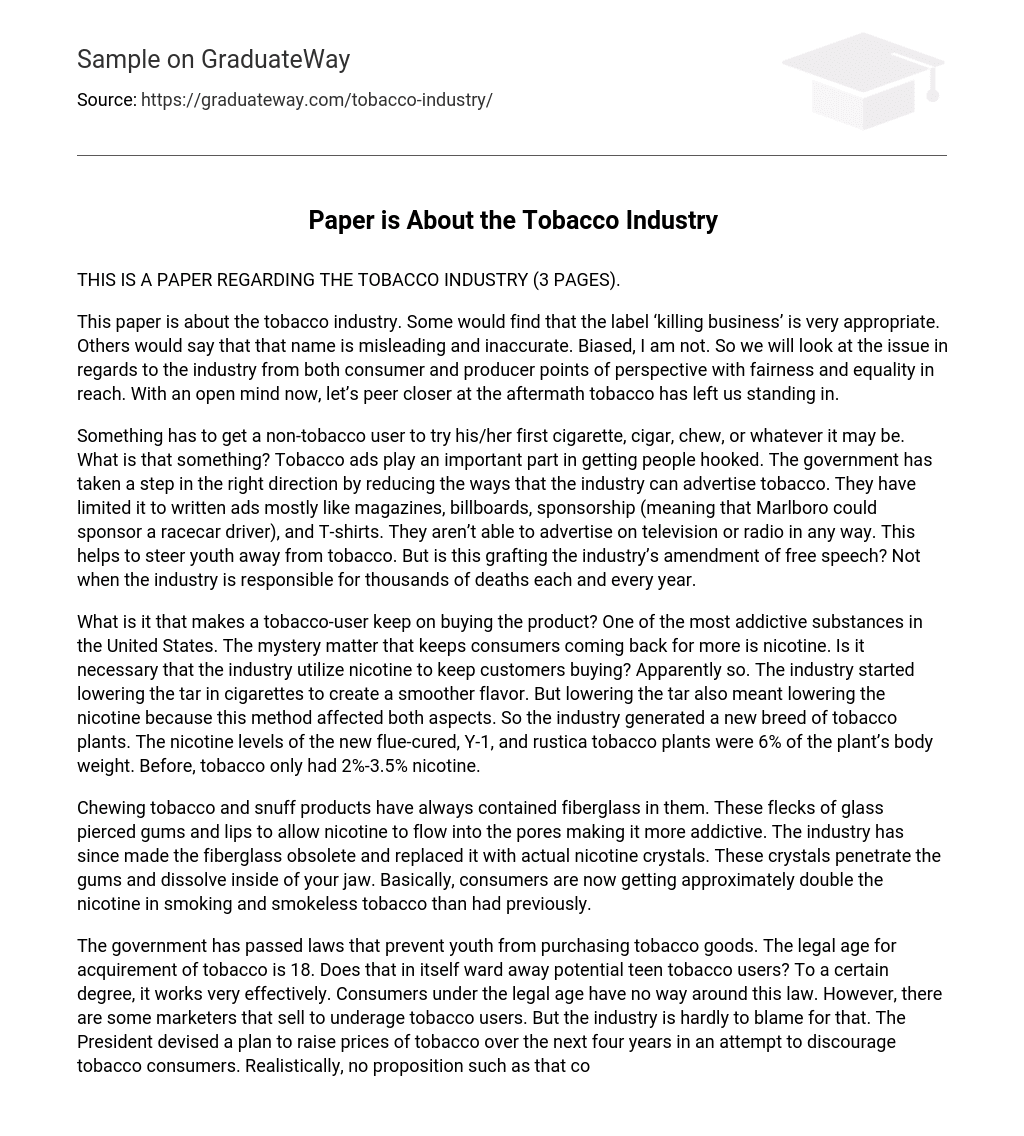THIS IS A PAPER REGARDING THE TOBACCO INDUSTRY (3 PAGES).
This paper is about the tobacco industry. Some would find that the label ‘killing business’ is very appropriate. Others would say that that name is misleading and inaccurate. Biased, I am not. So we will look at the issue in regards to the industry from both consumer and producer points of perspective with fairness and equality in reach. With an open mind now, let’s peer closer at the aftermath tobacco has left us standing in.
Something has to get a non-tobacco user to try his/her first cigarette, cigar, chew, or whatever it may be. What is that something? Tobacco ads play an important part in getting people hooked. The government has taken a step in the right direction by reducing the ways that the industry can advertise tobacco. They have limited it to written ads mostly like magazines, billboards, sponsorship (meaning that Marlboro could sponsor a racecar driver), and T-shirts. They aren’t able to advertise on television or radio in any way. This helps to steer youth away from tobacco. But is this grafting the industry’s amendment of free speech? Not when the industry is responsible for thousands of deaths each and every year.
What is it that makes a tobacco-user keep on buying the product? One of the most addictive substances in the United States. The mystery matter that keeps consumers coming back for more is nicotine. Is it necessary that the industry utilize nicotine to keep customers buying? Apparently so. The industry started lowering the tar in cigarettes to create a smoother flavor. But lowering the tar also meant lowering the nicotine because this method affected both aspects. So the industry generated a new breed of tobacco plants. The nicotine levels of the new flue-cured, Y-1, and rustica tobacco plants were 6% of the plant’s body weight. Before, tobacco only had 2%-3.5% nicotine.
Chewing tobacco and snuff products have always contained fiberglass in them. These flecks of glass pierced gums and lips to allow nicotine to flow into the pores making it more addictive. The industry has since made the fiberglass obsolete and replaced it with actual nicotine crystals. These crystals penetrate the gums and dissolve inside of your jaw. Basically, consumers are now getting approximately double the nicotine in smoking and smokeless tobacco than had previously.
The government has passed laws that prevent youth from purchasing tobacco goods. The legal age for acquirement of tobacco is 18. Does that in itself ward away potential teen tobacco users? To a certain degree, it works very effectively. Consumers under the legal age have no way around this law. However, there are some marketers that sell to underage tobacco users. But the industry is hardly to blame for that. The President devised a plan to raise prices of tobacco over the next four years in an attempt to discourage tobacco consumers. Realistically, no proposition such as that could ever be more ignorant and bemused. This scheme only gives rise to the industry. More profit for the tobacco unit would just make them that much wealthier. And in today’s world wealth is the father to power.
The whole raising prices idea has loopholes to it. Depending on how high the prices went up, some consumers would look the other way and decide that it’s time to abort the habit. Only to a certain poise would this method benefit anyone. If prices inflated, then some tobacco users would choose to quit. However, others would remain addicts and end up paying the difference on those who elected to stop using tobacco. The industry would still be profiting.
Due to the increasing number of deaths, cancer, and other mishaps caused by tobacco, questions have arisen about tobacco remaining legal in the United States. The tobacco industry has been a stain on American lifestyles. Consumers have helped an equal share to make it that way. What would occur if the government decided to ban tobacco? The death rate would definitely decrease and cancer levels would drop. America would be forced to stop the addiction. Would this result in a revolt against the government? No doubt tobacco users would be outraged. In the long run, though, banning it would be a step in the right direction. But something similar to this happened in the 1930’s with the prohibition of alcohol. That led to underground distribution and marketing of wine, beer, and other liquors. Based on common sense, more people would be likely to smoke a pack of cigarettes every day than drink a bottle of rum every day. What I’m saying is that tobacco is used more than liquor. So you can only imagine what effect the prohibition of tobacco would have.
In summary, both consumers and the industry are at fault for fatalities and cancers caused by tobacco. There must be some way that the tobacco users and the industry can meet halfway and mediate this conflict with both parties walking away happy. It’s unnecessary for the industry to load their products with overwhelming amounts of nicotine. It’s also unnecessary that consumers still continue to buy the stuff. Deaths wouldn’t be as common if the nicotine levels were lowered. Consumers would probably buy tobacco more if the risks drop. I think that would be a good answer to a bad problem.
JAKE KEITH





